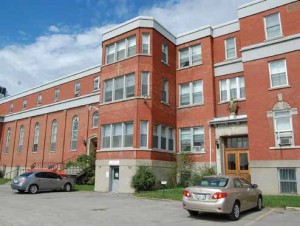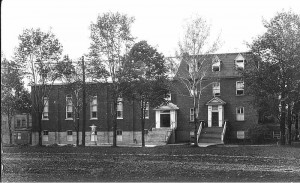PETER FROOD
Domicile Development, the current owner of the former Convent of the Sisters of the Sacred Heart of Jesus at 15 des Oblats Avenue, is in the process of selling its property, a move that raises questions about the future of this site. Will the new owners respect the Old Ottawa East (OOE) Secondary Plan? When can the community expect remediation work or the possible demolition of the Convent? Does future development on the Convent site create an opportunity to implement the vision and objectives set out in the OOE Secondary Plan without being ambushed by zoning amendments deviating from jointly developed, approved plans.
The answers to these questions will be revealed in time, but it is also time for the OOE community to be clear about its expectations.

The former Convent of the Sisters of the Sacred Heart on des Oblats Avenue. It is time for the Old Ottawa East community to be clear about its expectations for the future of the property, says Peter Frood, who believes that the opportunity to develop the site provides the City of Ottawa and developers with a way forward to repair the social contract with OOE residents that was breached by the cavalier decision to demolish the Chapel wing of the Deschâtelets Building. Photo Supplied
Currently, the zoning for the Convent property provides for low density residential development (up to four floors) on the part of the property facing Springhurst Avenue and for medium density residential development (up to 6 floors) on the property facing des Oblats Avenue. The current zoning for the Convent site is the same as what was in place to guide the development of The Corners on Main (TCOM) project, so it is quite conceivable that a similar scaling and mass of a building could be proposed for the adjacent site.
There are a number of measures that could be taken to make the redevelopment of the Convent site consistent with the OOE Secondary Plan.
First, the Convent should be nominated for inclusion in the Ottawa Register of Historic Places. At the very least, this will generate research on the Convent building, providing a better understanding of its heritage value and its association with other early buildings in OOE that have defined the evolution of this community. A heritage assessment would also assist the community and the City to evaluate planning and design proposals for the site.
The Secondary Plan specifically states that the statue of the Blessed Virgin and the associated grove of trees should be retained to commemorate the Sisters of the Sacred Heart. Part of the existing building could be deconstructed to create a greenspace corridor that would extend from Springhurst Avenue to des Oblats Avenue. As identified in the Secondary Plan, this would enhance bike and pedestrian connectivity between the surrounding neighbourhood and the Greystone development. Adoption of this measure would also demonstrate a commitment to the 15 minute walking neighbourhood priority identified in the draft Official Plan. Thoughtful landscape design could integrate the commemorative and connective functions as well as providing privacy screening for the TCOM Building. On des Oblats Avenue, the greenspace corridor would also break up the streetscape, facilitating the movement of air, increasing light and reducing the tunnel effect of a street lined on both sides by bulky buildings.
Based on the heritage analysis of the Convent, serious consideration should be given to adaptive reuse of at least part of the Convent building. The Convent was one of the early defining structures in OOE around which the community evolved. Retaining part of the Convent would complement the commemoration of the Sisters of the Sacred Heart, reflect the relationship between the Convent and the Deschâtelets Building and preserve the community’s past for current and future residents. An adaptive reuse strategy would reduce somewhat the carbon footprint of the project, while also providing a source of building materials for reintegration in the project or in public spaces.
If the Convent building cannot be reused, the heritage assessment could be used to inspire design elements into the new structure that echo the Convent building through references to the scaling, mass and details of the original building.
The OOE Secondary Plan clearly supports affordable housing, targeting 25% of future rental and ownership housing units. The intensification target for the Greystone development and Sacre Coeur is 1000 units. Applying this target, the development should include approximately 250 affordable housing units. Thus far, there are none. With the exception of some proposed assisted seniors housing on the top floor of the Deschâtelets Building, Greystone Village is an affluent ghetto. And it seems that the proposed Ottawa Official Plan amendments are retreating from a commitment to affordable housing for OOE. These trends are disturbing and not consistent with an ethos of fairness and equity deeply embedded in the OOE community. It is time to stop ignoring the target by taking a stand to ensure that affordable housing units are incorporated into the Convent redevelopment.
All of the foregoing options are grounded in or consistent with objectives clearly set out in the OOE Secondary Plan. Now is the moment in time for the community to affirm its expectations and expect the best from project proponents looking to develop the Convent site.
Importantly, the proposals noted above also present a way forward through which the City and developers can repair the social contract with residents of OOE that was broken through opportunistic bylaw amendments and the cavalier decision by Council to demolish inconvenient parts of the heritage-designated Deschâtelets
Building.







